Five weeks ago, Nvidia released its Pascal flagship, the GTX 1080 reference Founders Edition video card which decisively took the performance crown from Nvidia’s TITAN X and from the GTX 980 Ti as well as easily beating AMD’s flagship, the Fury X. BTR has recently received an EVGA GTX 1080 FTW which is factory overclocked by EVGA right out of the box. We have put it through its paces with what is probably the largest PC game benchmark suite in the English language, 26 games. We compare the FTW’s performance – at EVGA’s factory overclock and further overclocked by us – with the Founders Edition and also with the Fury X . Since all three cards retail for over $600, they make for a natural comparison, and we will use 3 resolutions up to 4K to determine the overall value/performance winner.
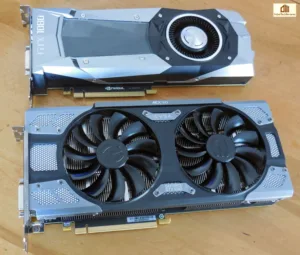 We have already benchmarked the reference Founders Edition of the GTX 1080 and also overclocked it, and found it is generally more than 30% faster than the TITAN X and the GTX 980 Ti. For this review we have updated our benchmark suite to Nvidia’s latest WHQL 368.39 GeForce drivers, and for Fury X, we used the latest 16.6.1 Crimson Hotfix beta drivers.
We have already benchmarked the reference Founders Edition of the GTX 1080 and also overclocked it, and found it is generally more than 30% faster than the TITAN X and the GTX 980 Ti. For this review we have updated our benchmark suite to Nvidia’s latest WHQL 368.39 GeForce drivers, and for Fury X, we used the latest 16.6.1 Crimson Hotfix beta drivers.
We will not recap Nvidia’s Pascal architecture here as with our GTX 1080 Founders Edition launch article, but will instead focus on the performance of the new EVGA GTX 1080 FTW versus the Founder’s Edition and against the Fury X.
This evaluation is focused on each card’s performance, primarily comparing the EVGA GTX 1080 FTW against the Founders Edition of the GTX 1080, and we will try to answer the question, which card should you buy? We will then place this evaluation into our larger context of 13 video card configurations which we call “The Big Picture” to see if you should consider an upgrade or not.
Let’s briefly look at the EVGA GTX 1080 FTW to see what it brings compared with the GTX 1080 Founders Edition.
The EVGA GTX 1080 FTW ACX 3.0+
The EVGA GeForce GTX 1080 featuring EVGA ACX 3.0 cooling has arrived with a retail price of $679, or $20 less than the Founders Edition of the GTX 1080 which is priced at $699.
This EVGA GTX 1080 FTW is clocked the highest of any of the currently available air-cooled EVGA cards which also feature EVGA ACX 3.0 cooling technology. EVGA ACX 3.0 once again brings new features to the award winning EVGA ACX cooling technology and is a step up over the GTX 980 Ti ACX 2.0 cooling which we reviewed in May of last year. EVGA gives increased heatpipes and copper contact area for cooler operation, and optimized fan curve for even quieter gaming than the earlier version.  Select EVGA ACX 3.0 models including the FTW will even feature a 10CM fan and RGB LED, allowing complete control over the color from EVGA’s PrecisionX OC.
Select EVGA ACX 3.0 models including the FTW will even feature a 10CM fan and RGB LED, allowing complete control over the color from EVGA’s PrecisionX OC. It looks very nice installed in our PC.
It looks very nice installed in our PC.

The GTX 1080 FTW card features EVGA’s ACX 3.0 cooling technology which improves on the current Maxwell EVGA ACX 2.0+ cooling technology. According to EVGA, a memory MOSFET Cooling Plate reduces MOSFET temperatures up to 13%, and optimized Straight Heat Pipes additionally reduce GPU temperature by 10C. ACX 3.0 coolers also feature optimized swept fan blades, double ball bearings and an extremely low-power motor. What this means is that this card is kept cool while being very quiet. The GDDRX memory, the fastest available, is also kept up to 13% cooler, while overall noise is reduced by up to 15%; the fan will even shut down when the card is not under load.
Exclusive Features for EVGA’s GeForce GTX 1080 ACX 3.0 including the FTW:
- DirectX 12 OSD Support – See the on screen display on DirectX 12 games.
- EVGA OC ScannerX Integration – Automatically find your optimal voltage/frequency curve!
- K-Boost Function – Maximize your clocks with this exclusive feature.
- RGB LED control (on EVGA GeForce GTX 1080 FTW)
You can find out much more here. As a recap, here are the specifications for the reference GTX 980 Ti:

Here are the specifications and key features for the EVGA GTX 980 Ti SC+.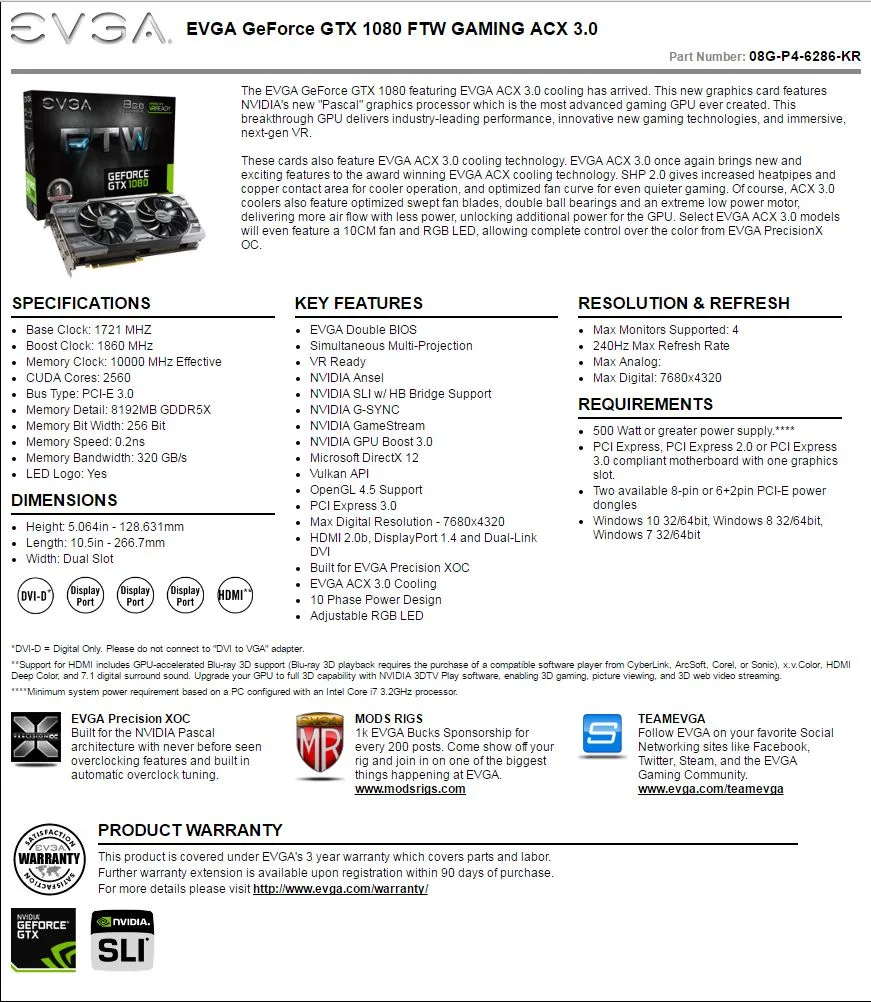 The EVGA FTW’s card’s base clock is 1721MHz, up 114MHz over the reference Founders Edition base clock, and the EVGA boost clock is 1860MHz, 127MHz higher than Nvidia’s guaranteed minimum reference boost of 1733MHz. We will show the boost and base clocks that we actually got compared with our sample of the Founders Edition, and we will also compare both cards clocked as far as we could stably push them without adding any extra voltage or adjusting the fan profiles.
The EVGA FTW’s card’s base clock is 1721MHz, up 114MHz over the reference Founders Edition base clock, and the EVGA boost clock is 1860MHz, 127MHz higher than Nvidia’s guaranteed minimum reference boost of 1733MHz. We will show the boost and base clocks that we actually got compared with our sample of the Founders Edition, and we will also compare both cards clocked as far as we could stably push them without adding any extra voltage or adjusting the fan profiles.
Notice that the GDDR5X memory is not further overclocked by EVGA. There is a really good reason for this which we shall detail in our overclocking section.
From what we can see, the specifications of the EVGA GTX 1080 FTW are impressive, and it clocked significantly higher than the reference Founders Edition version, and with a quieter cooler. You are also covered by EVGA’s 3-year warranty with a further warranty extension available upon registration within 90 days of purchase. The GTX 1080 reference Founders Edition versions are generally chosen for multi-GPU configurations, while the FTW is usually best chosen for a single card.
Our EVGA GTX 1080 FTW ACX 3.0 came from EVGA via TechofTomorrow. EVGA wants to make it very clear that what they sent is the same as what you can buy from any etailer. EVGA sent out this press release two days ago:
EVGA was one of the first graphics card companies to offer overclocked graphics cards, and since day one EVGA always delivered the exact same products to reviewers as well as customers. EVGA does not “fake” reviews or send out products with “tweaked” clockspeeds to reviewers. With EVGA Superclocked, FTW and Classified graphics cards, what you see is what you get.
Learn more at http://www.evga.com/articles/01022/evga-wysiwyg/
Our Big Picture Testbed of Competing Cards
Our testbed of competing cards tests 26 games and 1 synthetics using Core i7-4790K turbo locked to 4.4GHz by the motherboard’s BIOS, ASUS Z97+ motherboard and 16GB of Kingston “Beast” 2133MHz HyperX DDR3.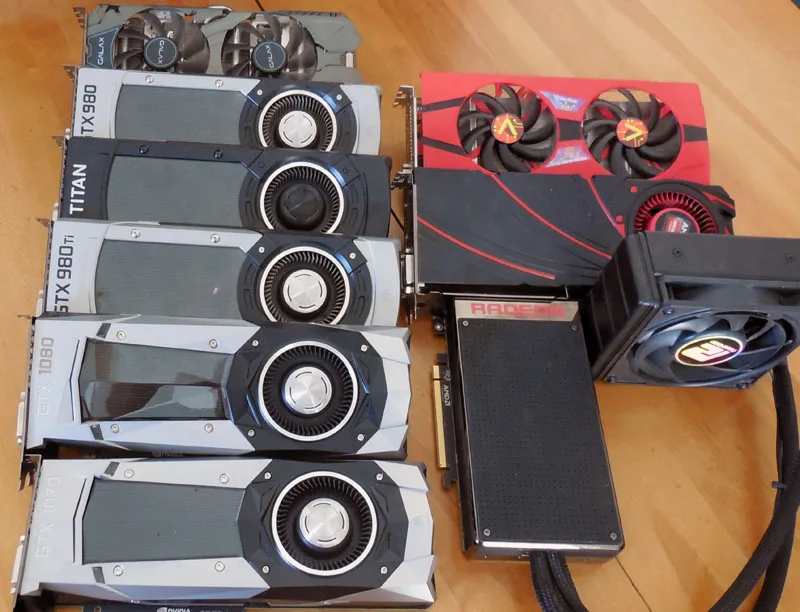
This evaluation will pit the stock and overclocked EVGA GTX 1080 FTW against the reference Founders Edition of the GTX 1080, and also against the Fury X. Our bigger picture will show the other top cards, the GeForce TITAN X, and the GTX 980 Ti, and the GTX 980, as well as the GTX 980 and GTX 980 Ti SLI, plus our PowerColor reference design R9 290X at locked-on boost speeds (1000MHz), as well as with the VisionTek R9 290X in CrossFire. We also show the GALAX GTX 970 EXOC and the PowerColor 280X for a comparison. We are using 26 modern games and 1 synthetic benchmark at 1920×1080, 2560×1440, and at 3480×2160 resolutions.
How does the EVGA GTX 1080 FTW compare with its rival, AMD’s top single GPU, the Fury X?
Well, it simply doesn’t. The Fury X is completely outclassed and outperformed in every single benchmark by the Founders Edition of the GTX 1080 and it barely matches the $379/429 GTX 1070 even though it still regularly sells for over $600.
Let’s take a closer look at the new EVGA GTX 1080 FTW ACX 3.0.
Unboxing the EVGA GTX 1080 FTW ACX 3.0
The EVGA GTX 980 Ti SC+ comes in a standard sized box that advertises its 8GB GDDR5X, the fact that it is “VR Ready”, and that it is ready for GameStream/GameWorks/G-SYNC/DX12. The sides and back of the box shows that it uses ACX 3.0 cooling, supports 4 concurrent displays and advertises its Key features, as well as emphasizes the 3-year EVGA warranty.
The sides and back of the box shows that it uses ACX 3.0 cooling, supports 4 concurrent displays and advertises its Key features, as well as emphasizes the 3-year EVGA warranty.
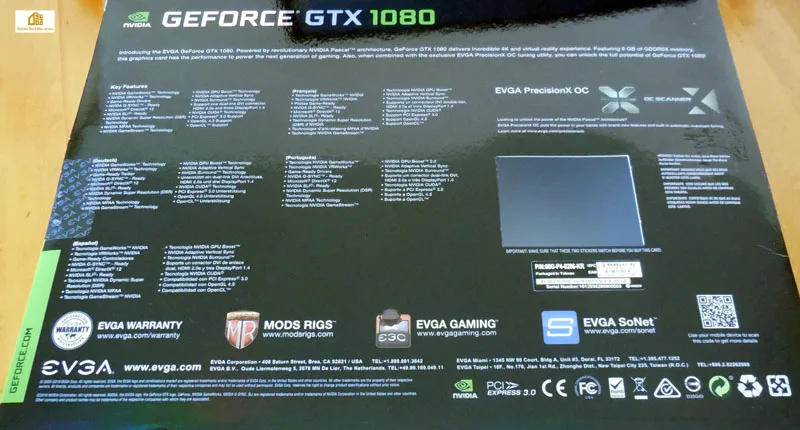
Here is everything out of the box.  The card is packed securely and EVGA no longers uses a anti-static plastic clamshell which we always considered wasteful. Instead it comes in a anti-static bag which often proves more useful than the clamshell.
The card is packed securely and EVGA no longers uses a anti-static plastic clamshell which we always considered wasteful. Instead it comes in a anti-static bag which often proves more useful than the clamshell.  It comes with two large stickers, a “Powered by EVGA” metal decal for your PC, a user and an installation guide, and two 6-pin to 8-pin PCIe power cable adapters. The EVGA GTX 1080 FTW ACX 3.0 is a handsome dual-fan card that covers a large radiator. The fans spin relatively slowly compared with the reference Founders Edition version. Of course, this makes perfect sense because there are two slower turning ACX 3.0 fans to remove the GPU heat, compared with a double speed single blower-style fan in the reference version.
It comes with two large stickers, a “Powered by EVGA” metal decal for your PC, a user and an installation guide, and two 6-pin to 8-pin PCIe power cable adapters. The EVGA GTX 1080 FTW ACX 3.0 is a handsome dual-fan card that covers a large radiator. The fans spin relatively slowly compared with the reference Founders Edition version. Of course, this makes perfect sense because there are two slower turning ACX 3.0 fans to remove the GPU heat, compared with a double speed single blower-style fan in the reference version.
We turn the card on its edge and look at the slim design cooling fins which allow the card to fit into a PC motherboard’s double slot configuration. Besides the power from the PCIe slot, there are two 8-pin connectors.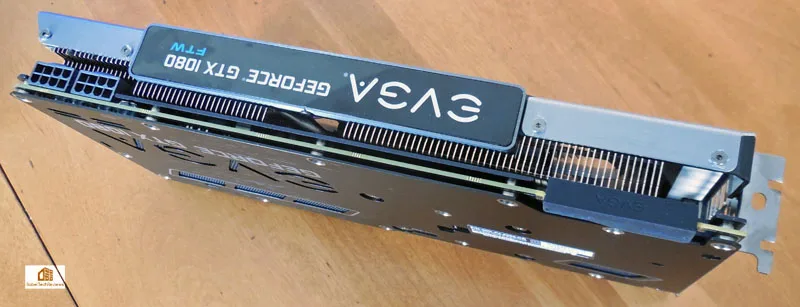
Here is a look from the other edge. The heatsink area is quite large.
As you can see the FTW card is the same length as the Founders Edition card. However, the FTW is considerably wider then the Founders Edition. The FTW backplate is sturdy, dissipates heat better, and it looks much nicer than a raw PCB.
However, the FTW is considerably wider then the Founders Edition. The FTW backplate is sturdy, dissipates heat better, and it looks much nicer than a raw PCB.
You can see the heatpipes in this view: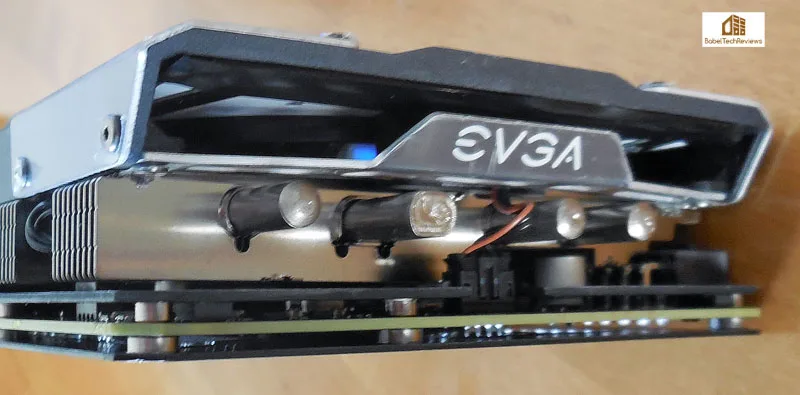
There are one dual link DVI port, 3 Display Ports and a HDMI 2.0 port. Unfortunately for its competitor, the Fury X only comes with 3 DisplayPorts and 1 HDMI 1.4 port, making it somewhat unsuitable for gaming at 60Hz on a 4K TV without an active DP adapter.
The specifications look extraordinary for the EVGA GTX 1080 FTW, with solid improvements over just about anything else from the previous generation. Let’s check out its performance versus the Founders Edition and versus the Fury X after we look over our test configuration on the next page.
Test Configuration – Hardware
- Intel Core i7-4790K (reference 4.0GHz, HyperThreading and Turbo boost is on to 4.4GHz; DX11 CPU graphics), supplied by Intel.
- ASUS Z97-E motherboard (Intel Z97 chipset, latest BIOS, PCIe 3.0 specification, CrossFire/SLI 8x+8x)
- Kingston 16 GB HyperX Beast DDR3 RAM (2×8 GB, dual-channel at 2133MHz, supplied by Kingston)
- EVGA GTX 1080 FTW, 8GB, factory overclocked by EVGA and also further overclocked, supplied by EVGA on loan from TechofTomorrow.
- GTX 1080, 8GB, Founder’s Edition, reference clocks supplied by Nvidia
- GTX 1070, 8GB Founder’s Edition, reference clocks, supplied by Nvidia
- GeForce GTX 980 Ti, 6GB in SLI and also tested as single GPU, reference clocks, supplied by Nvidia
- EVGA GTX 980 Ti SC, 6GB in SLI and also tested as single GPU, at reference reference clocks, supplied by EVGA
- 2 x GeForce GTX 980, 4GB, reference clocks, in SLI and also tested as single GPU, supplied by Nvidia
- GALAX GTX 970 EXOC 4GB, GALAX factory overclock, supplied by GALAX
- PowerColor R9 Fury X 4GB, at reference clocks.
- VisionTek R9 290X 4GB, reference clocks, in CrossFire and also tested as single GPU; fan set to 100% to prevent throttling.
- PowerColor R9 290X, 4GB, reference clocks, in CrossFire; fan set to 100% to prevent throttling.
- PowerColor R9 280X, 3GB, reference clocks, supplied by PowerColor.
- Two 2TB Toshiba 7200 rpm HDDs
- EVGA 1000G 1000W power supply unit
- Cooler Master 2.0 Seidon, supplied by Cooler Master
- Onboard Realtek Audio
- Genius SP-D150 speakers, supplied by Genius
- Thermaltake Overseer RX-I full tower case, supplied by Thermaltake
- ASUS 12X Blu-ray writer
- Monoprice Crystal Pro 4K
Test Configuration – Software
- Nvidia’s GeForce WHQL 368.39 was used to bench the EVGA FTW and the Founder’s Edition of the GTX 1080. High Quality, prefer maximum performance, single display. Nvidia divers used in the Big Picture are noted on the chart.
- The AMD Crimson Software 16.6.1 beta hotfix drivers were used for benching the Fury X. All other AMD drivers are noted on the Big Picture.
- VSync is off in the control panel.
- AA enabled as noted in games; all in-game settings are specified with 16xAF always applied
- All results show average frame rates including minimum frame rates shown in italics on the chart next to the averages in smaller font.
- Highest quality sound (stereo) used in all games.
- Windows 10 64-bit Home edition, all DX11 titles were run under DX11 render paths. Our only DX12 title is run under the DX12 render path. Latest DirectX
- All games are patched to their latest versions at time of publication.
- EVGA’s Precision XOC, reviewer’s version 4 used for Nvidia cards.
The 26 PC Game benchmark suite & 1 synthetic test
- Synthetic
- Firestrike – Basic & Extreme
-
DX11* Games
- Crysis 3
- Metro: Last Light Redux (2014)
- GRID: Autosport
- Middle Earth: Shadows of Mordor
- Alien Isolation
- Dragon’s Age: Inquisition
- Dying Light
- Total War: Attila
- Grand Theft Auto V
- ProjectCARS
- the Witcher 3
- Batman: Arkham Origins
- Mad Max
- Fallout 4
- Star Wars Battlefront
- Assassin’s Creed Syndicate
- Just Cause 3
- Rainbow Six Siege
- DiRT Rally
- Far Cry Primal
- Tom Clancy’s The Division
- DOOM (*OpenGL)
- Mirror’s Edge Catalyst
- DX12 Games
- Ashes of the Singularity
- Hitman
- Rise of the Tomb Raider
Nvidia’s Control Panel settings: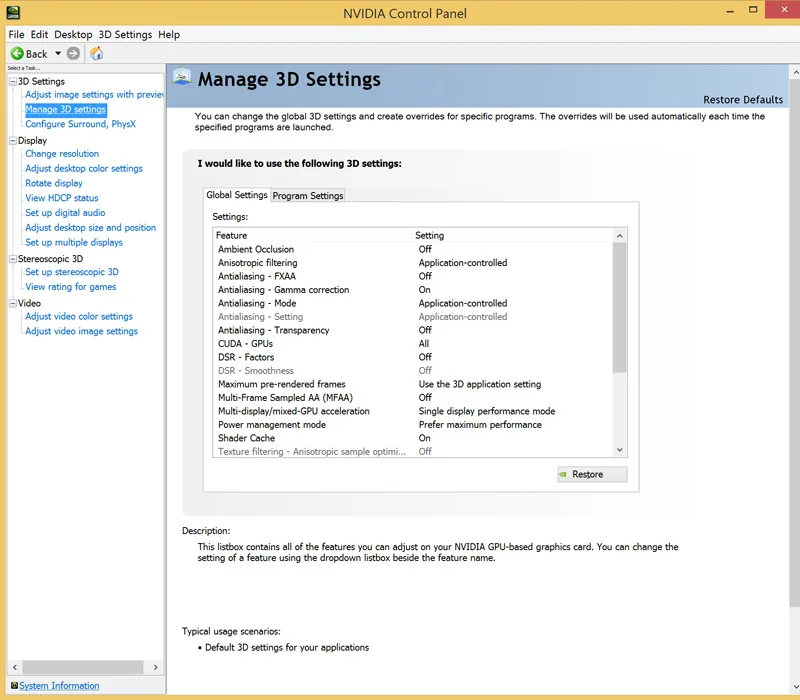
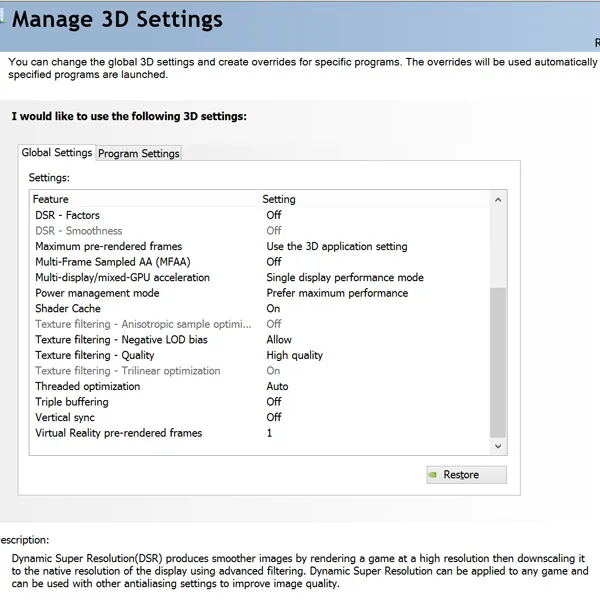 Let’s head to our overclocking section next.
Let’s head to our overclocking section next.
Overclocking the EVGA GTX 1080 FTW ACX 3.0+
Overclocking the Pascal GTX 1080 and the EVGA GTX 1080 FTW is not as easy as overclocking the GeForce TITAN X, the GTX 980, or any other Maxwell architecture-based card. We already overclocked the Founders Edition of the GTX 1080 with PrecisionX OC and you can read about our results here.
Unfortunately, we were unable to upgrade to the latest version of PrecisionX OC as it has activation issues for some users, and it refused to launch. EVGA is aware of our issues but for now, we are still stuck with the Beta Reviewer’s Edition 4 which is not completely stable. This means that we could not use the Scanner to set or fine tune our overclock, but we were forced to set it manually. We expect that PrecisionX OC should be able to get a higher overclock than we managed.
In line with BTR’s overclocking policy, we only set the Temperature and Power Target sliders to their maximum and did not adjust the fan profile nor add any extra voltage. This are the clocks that we get just above idle.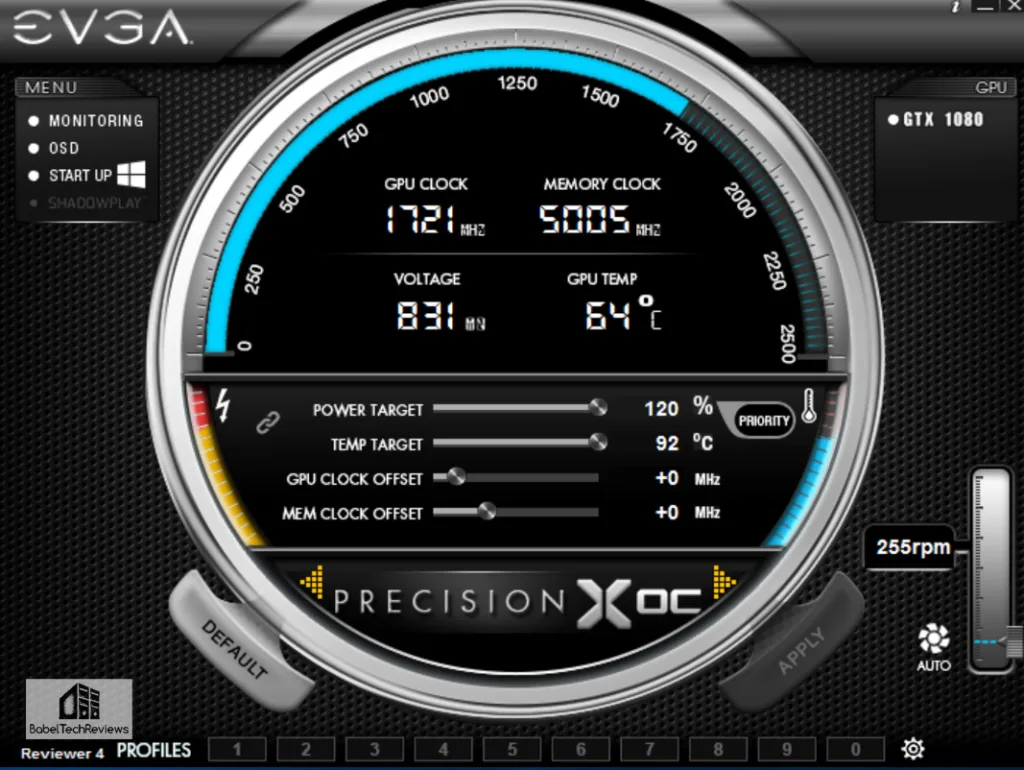
This is the maximum overclock that we achieved with the Founders Edition

Ultimately, the final stable overclock for BTR’s GTX 1080 sample is +190MHz core offset leading to an average boost over 1950MHz and a +400MHz memory offset resulting in a 5400MHz memory clock. This is with a power target of +110% (not 120% which is unstable) and a temperature target of 91C. However, there were 2 problematic games out of 26 games that required an adjustment downward – GTA V (which has always been extremely sensitive to all overclocking) and Ashes of the Singularity (which has been somewhat problematic for Nvidia cards) which required lowering the offset by 20MHz to +170MHz offset.
The EVGA GTX 1080 FTW is already overclocked from the EVGA factory. The EVGA FTW’s card’s base clock is 1721MHz, up 114MHz over the reference Founders Edition base clock, and the EVGA boost clock is 1860MHz, 127MHz higher than Nvidia’s guaranteed minimum reference boost of 1733MHz. We also managed a completely stable additional +55MHz offset on the EVGA card’s core and an extra +100MHz offset on the FTW’s memory which turned out to be somewhat problematic for a couple of games.
Here is our maximum overclock with the EVGA GTX 1080 FTW:
UPDATED 06/23/16: As in the screenshot above, we looped Heaven 3.0 continuously, and the worst case is pictured with the fan speed at ~1570 rpm and the temperature at 77C in a very warm testing environment (80F). The fan speed and voltage were left on auto and the FTW never throttled.
We eventually settled on +55MHz core offset and +100MHz offset to the memory as +300 was stable, but even an offset of +200 lowered the performance results. We still achieved a steady GPU 3.0 locked-on Boost of 2012MHz, or +51MHz higher than with the Founders Edition, and at a much cooler temperature and lower fan speed/noise – all using the automatic profiles and without adding any extra voltage. We believe we could have done even better with the latest version of PrecisionX OC, but it refused to activate and launch for us. Maximum boost was 2050MHz.
You can download PrecisionX directly here: www.evga.com/precision where you can download it for free. It is also available for free on Steam.
A note about Memory Overclocking
The EVGA GTX 1080 FTW didn’t overclock as well with its GDDR5X as our sample of the Founders Edition which was able to gain performance with a +300MHz offset. In contrast, the FTW lost performance at +200MHz although it remained stable. In fact, one game – Mirror’s Edge Catalyst – lost significant performance with our +100MHz memory offset and we benchmarked it on our charts without a memory overclock, choosing to only overclock the core +55MHz. Two other games – Dragon’s Age Inquisition and Assassin’s Creed Syndicate – didn’t lose any performance with the +100MHz memory offset, but gained a very slight performance gain without it, so we showed those results on our chart.
We would recommend that each end user test any memory overclock very thoroughly before deciding on it. If the memory clocks are set even slightly high, the performance may drop. In most cases, based on our experience with the EVGA GTX 1080 FTW, we might even advise against any memory overclock because of the very slight gains experienced with it.
Let’s head to the performance charts to see how the EVGA GTX 1080 FTW compares with Founders Edition, with Fury X, and with the top cards of Summer, 2016.
Performance summary chart
The EVGA GTX 1080 FTW stock and overclocked vs. the reference Founders Edition and vs. the Fury X
All results except for Firestrike are expressed in average fps (in Bold) and also generally in minimum fps (where they make sense, in smaller font italics next to the averages). The stock EVGA factory overclocked GTX 1080 FTW performance results are in Column 1, the reference Founders Edition is in the second column (in black text), our user-overclocked EVGA GTX 1080 FTW is in the third, and the last column shows Fury X stock results.
Here are our results of 26 games and 1 synthetic test. An Asterisk (*) means that there are some real issues with the visuals.
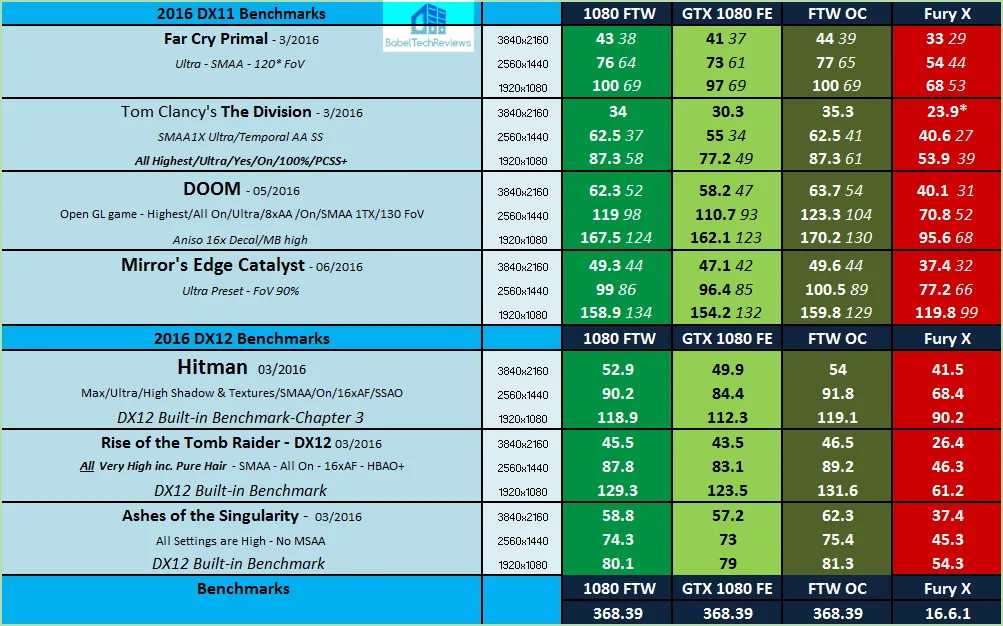 As you can see, the factory-set EVGA overclock brings a decent performance increase over the Founders Edition and our additional overclock of +55MHz to the core and +100MHz to the memory generally brings another small increase showing there is good scaling with overclocking. However, we would caution against memory overclocking and recommend that each end user test it out for themselves since in a few games, overclocking the memory even by a small amount may degrade performance.
As you can see, the factory-set EVGA overclock brings a decent performance increase over the Founders Edition and our additional overclock of +55MHz to the core and +100MHz to the memory generally brings another small increase showing there is good scaling with overclocking. However, we would caution against memory overclocking and recommend that each end user test it out for themselves since in a few games, overclocking the memory even by a small amount may degrade performance.
The main summary chart: The Big Picture
This main summary chart is what we call, “The Big Picture” since it places our three test cards into a much larger 13-configuration test bed. Driver revisions for each card are noted on the chart. An “X” means the benchmark was not run, while “NA” means the benchmark could not be run or completed. And an Asterisk (*) means that there are some real issues with the visuals. All results except for Firestrike are expressed in average fps (in Bold) and also generally in minimum fps (where they make sense, in smaller italics next to the average results).
Make sure to open this chart in another window or in a separate tab for better readability.
What we can take away from the results generally is that the EVGA GTX 1080 FTW is the fastest single GPU video card – period! Overall, it edges out the Founders Edition and it is significantly faster than the Fury X.
When we compare the $600-$650 Fury X against the $679 EVGA GTX 1080 FTW, the value to performance gap may even widen further in favor of the GeForce. And the EVGA FTW card is generally faster than the reference Founders Edition which costs $20 more! As an added bonus, the GTX 1080 FTW is the quietest card of all tested including the Fury X which is very quiet indeed. And the FTW runs much cooler than the Founders Edition.
UPDATED 06/23/16 – If you would like to watch the video using these same benchmarks on Youtube, Please check out TechofTomorrow.
Let’s head for our conclusion.
The Conclusion
We have no trouble giving a big recommendation to the EVGA GTX 1080 FTW ACX 3.0. At $679 it looks great, runs cool and is very quiet, and its out of the box performance is higher than the Founders Edition of the GTX 1080 which costs $20 more. The only reason one might choose a reference Founder’s Edition GTX 980 Ti at $699 instead is to use 2 cards for SLI in a small case. Or perhaps one may prefer the “look” of the built-by Nvidia reference card.
The EVGA GTX 1080 FTW ACX 3.0 runs cooler than the Founders Edition, costs less, is quieter and is built just as well from what we can tell. Unfortunately, the lackluster performance of the Fury X in a similar price range at around $600-650 leaves it out of contention in our opinion. The GTX 1080 is much faster and it wins every single benchmark in our 26-game benchmark suite.
EVGA GTX 1080 FTW ACX 3.0 Pros
- The EVGA GTX 1080 FTX beats the more expensive Founders Editon in performance, and it beats its Fury X competitor in every benchmark at a similar price.
- TDP and power draw are good and it is very quiet in comparison to almost any other high-performance video card and it is quieter than the reference GTX 1080 Founders Edition, especially when overclocked.
- Overclockability is excellent out of the box – GPU Boost 3.0 works as advertised.
- It is possible to use two of these cards for extreme SLI performance in games that support it.
- The card is well-built, looks great and the LED lighting is a nice touch.
- The GeForce Experience and GameWorks, including ShadowPlay, enhance the gaming experience. G-SYNC helps to smooth gaming framerates by syncing the display to the GPU and allowing for smooth framerates without stuttering or tearing.
Cons
- PrecisionX OC refused to launch for us after activation. We probably left overclocking performance on the table by setting our overclock manually by being unable to use the advanced overclocking features it offers.
The Verdict:
- If you are buying the ultimate single-GPU flagship video card right now and looking for the highest performance in a single GPU, the GTX 1080 is the only reasonable choice in its price range and the EVGA card is well deserving of its $679 price tag compared with the more expensive Founders Edition. We feel it deserves BTR’s Highly Recommended award because it is unique in design and performance as well as being among the very fastest cool and quiet air-cooled GTX 1080s.
- We would choose the EVGA GTX 1080 FTW ACX 3.0 in every situation over the reference Founders Edition except possibly for SLI.
We do not know what the future will bring, but the GTX 1080 brings an excellent top-performer to the GeForce family and it clearly establishes itself as the very fastest single-GPU video card in the world. On top of this, the EVGA GTX 1080 FTW ACX 3.0 is highly recommended for its excellent cooling and quietness as well as the great EVGA warranty and support.
If you currently game on an older generation video card, you will do yourself a big favor by upgrading. The move to a GTX 1080 will give you better visuals on the DX11 and DX12 pathways, and you are no doubt thinking of SLI if you want to get the very most in gaming performance. Price may be the only issue, but if you are looking for ultimate performance, the GTX 1080 is significantly faster than the Fury X.
AMD offers their own set of features including Eyefinity 2.0 and FreeSync, but their flagship Fury X as represented by the PowerColor Fury X card, simply cannot touch the raw power of the GTX 1080. We are hoping that AMD will soon bring a new architecture flagship card to the table.
Stay tuned, there is a lot coming from us at BTR. We are in the process of preparing for another new review and are also upgrading our platform from Devil’s Canyon Core i7-4790 to Skylake’s Core i7-6770K.
Happy Gaming!
Mark Poppin
BTR Editor-in-Chief

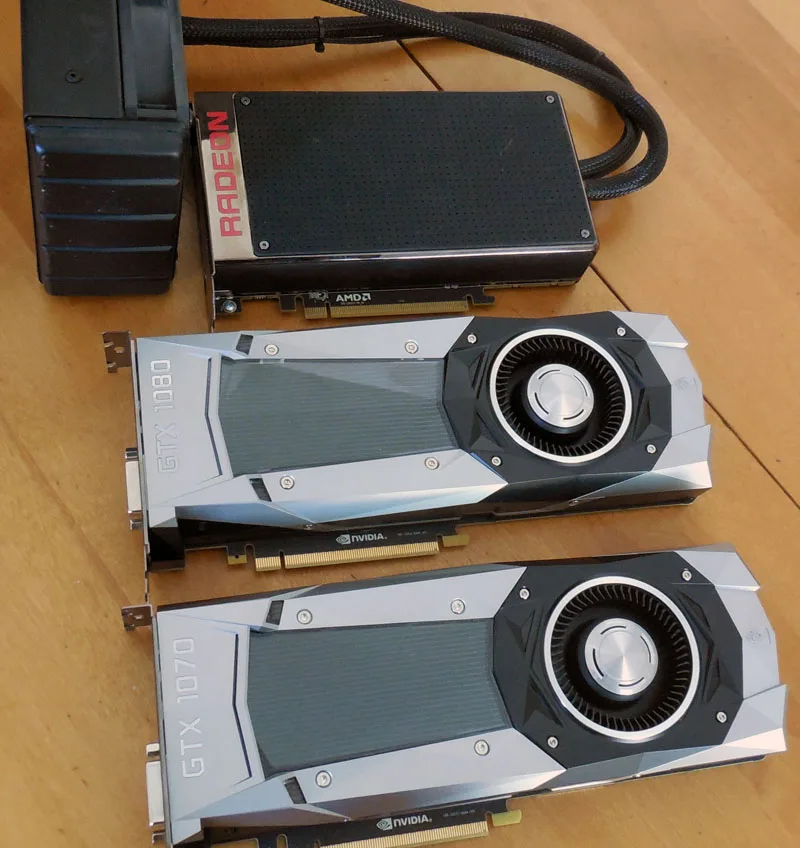
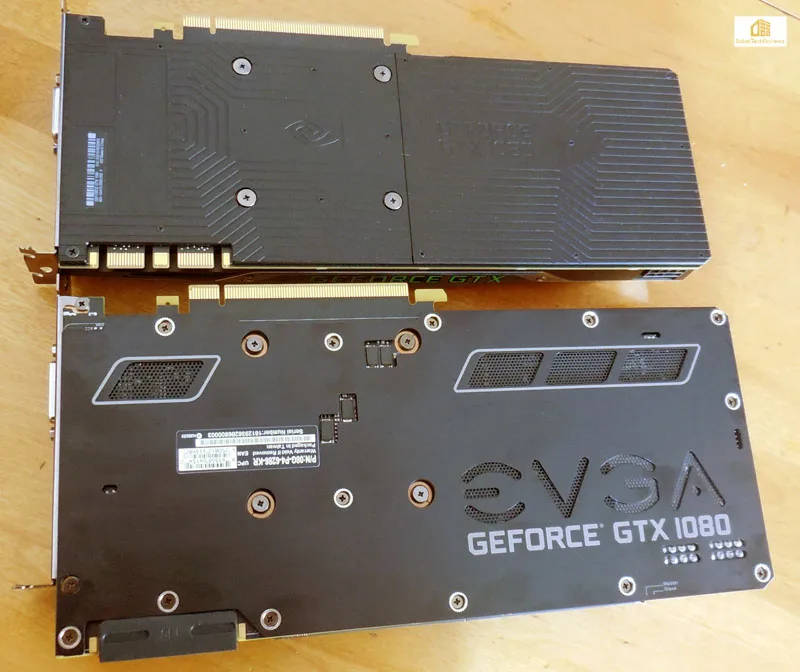
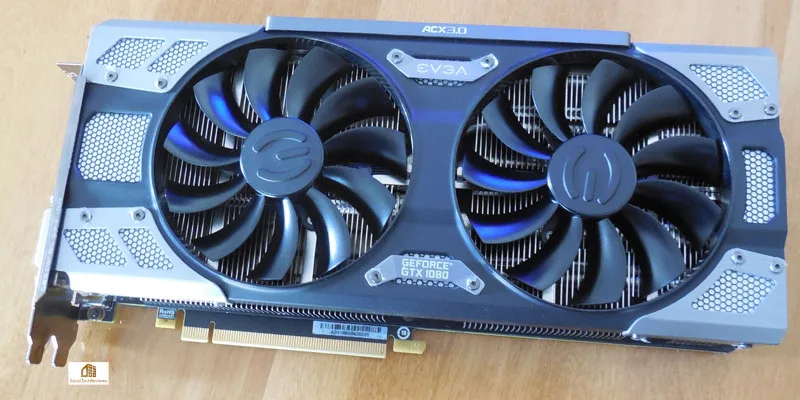
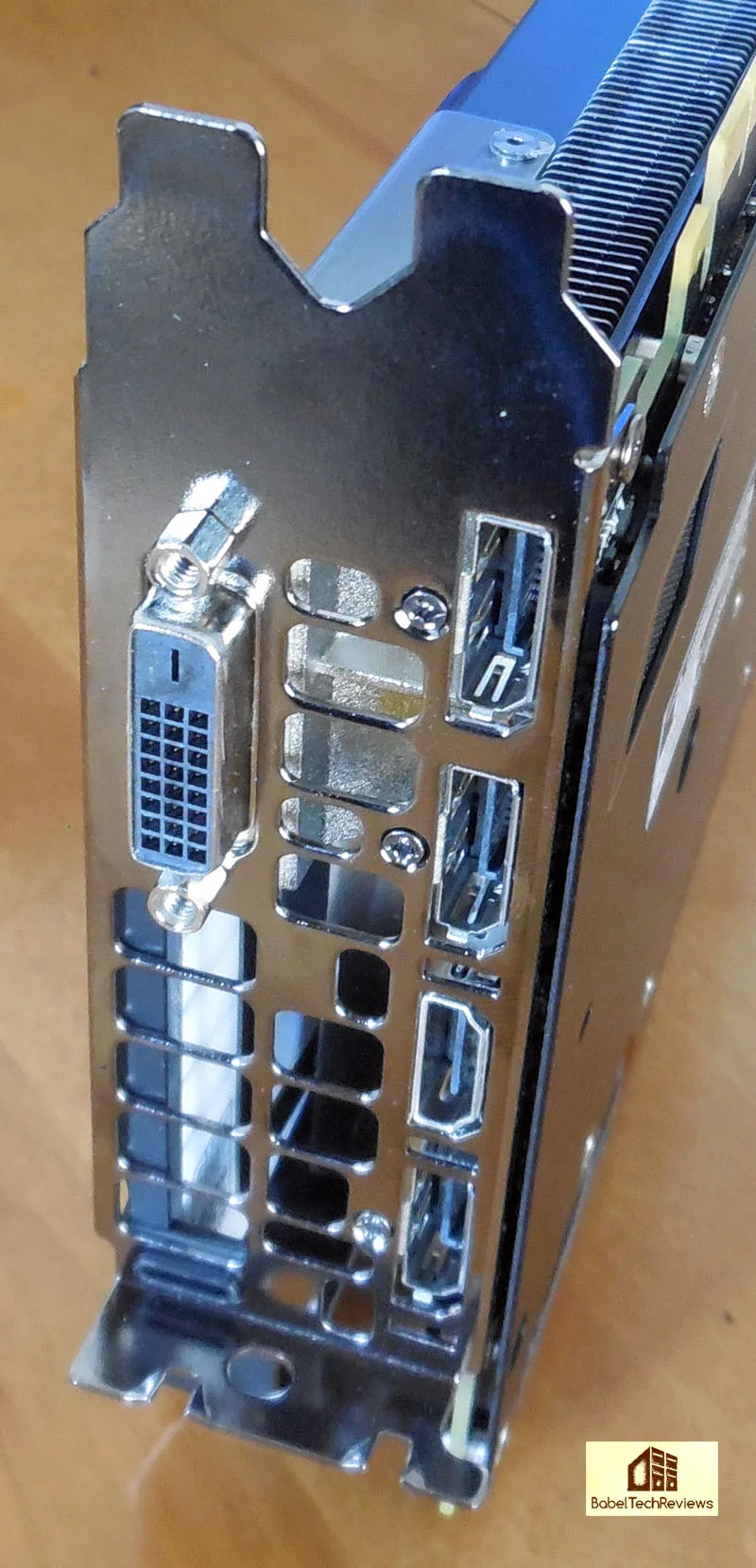
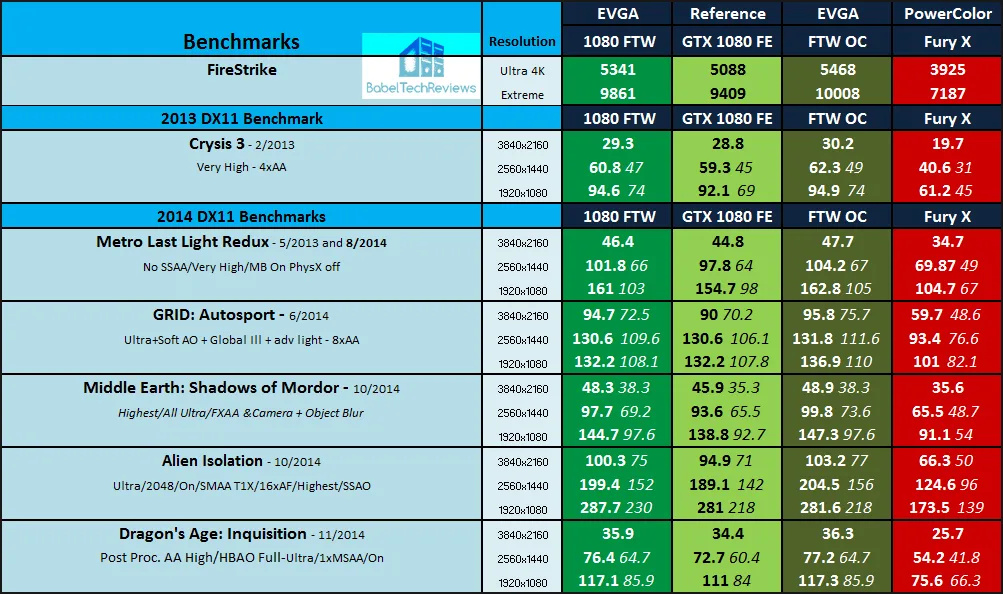
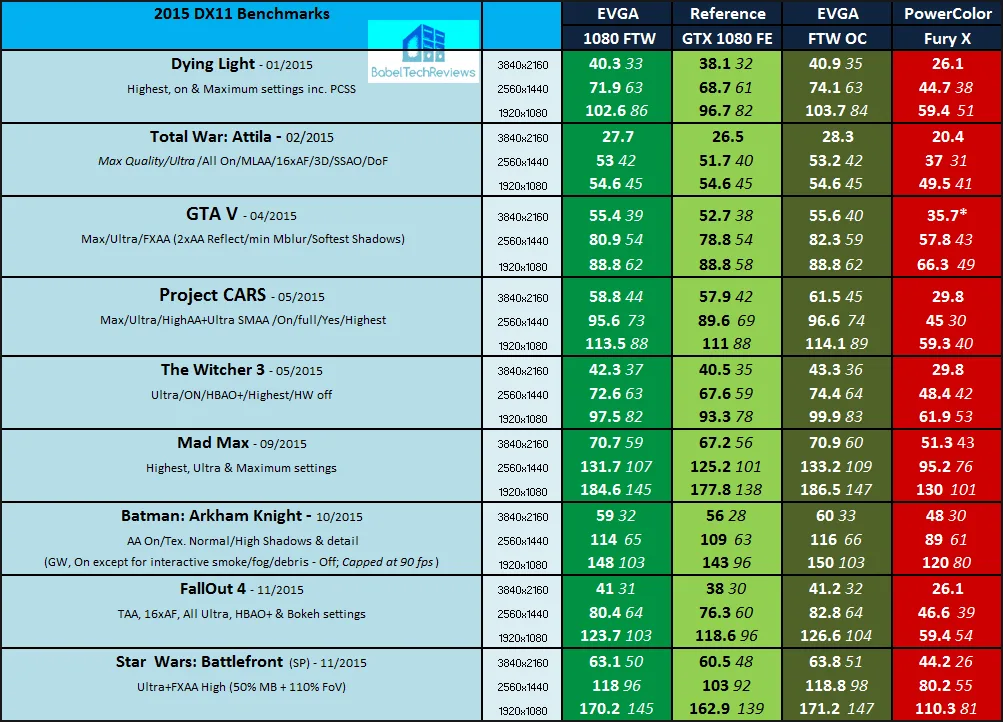
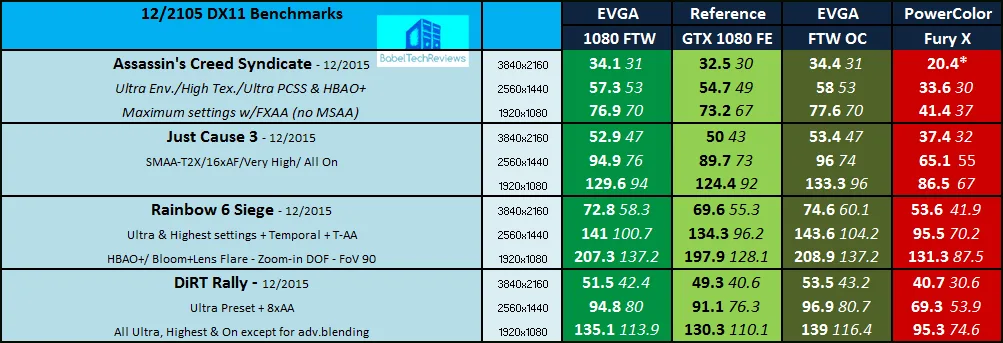

Comments are closed.